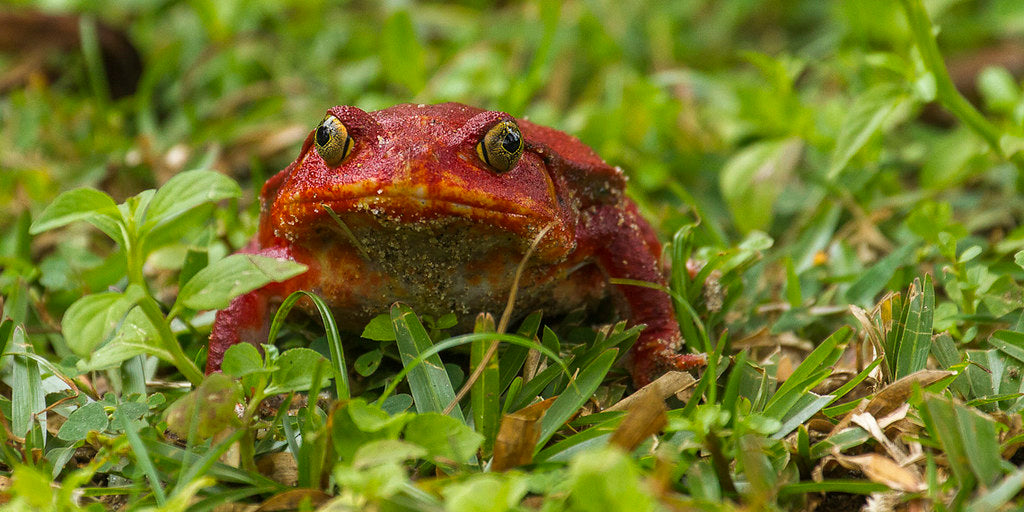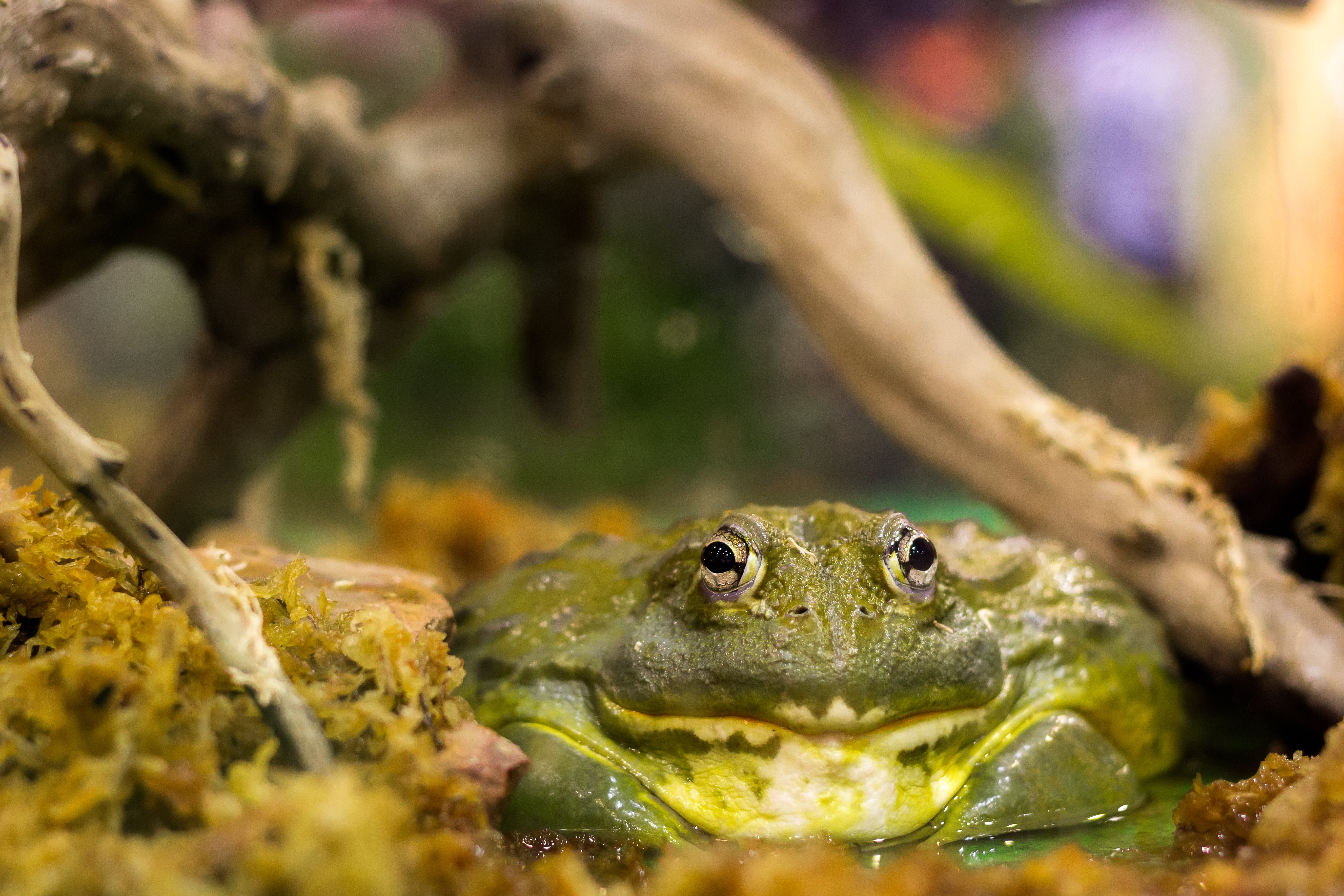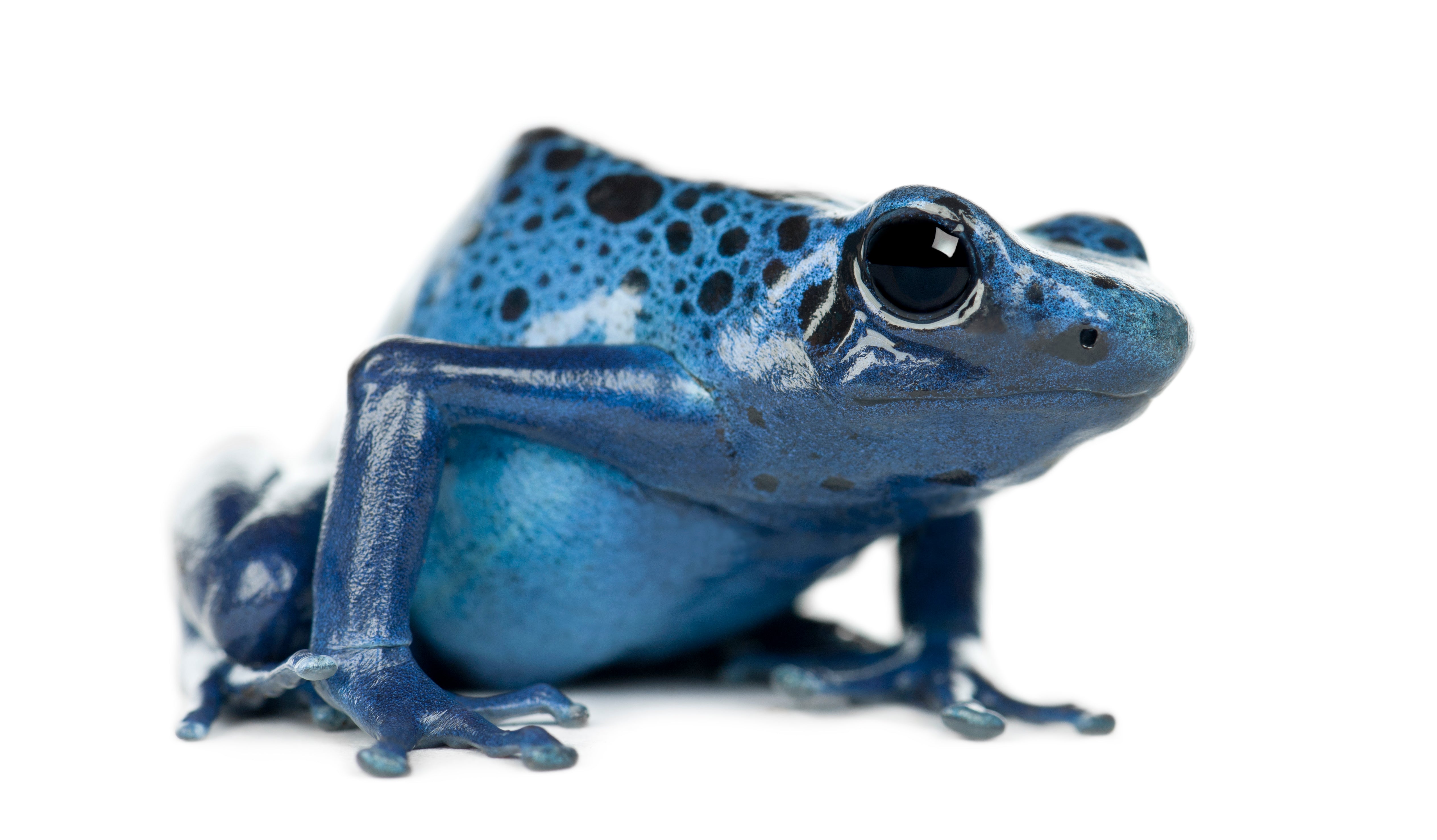The tomato frog (Dyscophus guineti) is a small, terrestrial, nocturnal species of amphibian. They are native to the island of Madagascar, and prefer the leaf-littered floor of its eastern rainforests.
Tomato frogs are typically 2.5-4” long, with males being smaller. They have small heads and mouths, bulbous bodies, short limbs, and smooth skin. They are red-orange in color, with a lighter orange belly and a dark stripe on each side. Their round shape and reddish color earns them their common name.
Due to their small size and general adaptability to captive conditions, tomato frogs are a beginner-level pet amphibian. With good care, they can live up to 10+ years.
How much space do tomato frogs need?
To house a tomato frog, you will need an enclosure no smaller than 30”L x 12”W x 12”H, or 20 gallons. This is just the minimum, so using larger dimensions is beneficial and will happily be used!
Cohabitation (keeping multiple tomato frogs in one enclosure) is optional, but not required. Tomato frogs do just fine when housed alone, but they can usually also be housed with other members of their species without incident.
Do tomato frogs need UVB?
They seem to be able to survive without it, but it’s still best practice to provide UVB lighting for optimal health and wellbeing. Providing UVB lighting to your frog gives them all of the vitamin D that their body needs, stimulates better appetite and activity, and generally allows them to be healthier than they would be without.
The best UVB bulbs for tomato frogs are:
- Zoo Med T8 Reptisun 5.0
- Arcadia ShadeDweller
The UVB bulb should be housed in a reflective fixture like the Arcadia ProT5 or Vivarium Electronics, and placed close to the heat lamp on top of the mesh lid, about 8-13” above the substrate. UVB is blocked by glass and plastic, so you can’t give your frog UVB by placing its terrarium in front of an open window. Also make sure that the fixture your UVB bulb is in does not have a clear plastic bulb cover. UVB bulbs decay over time, so don’t forget to replace your bulb every 12 months to maintain good performance.
Lights should be on for 13 hours/day during summer and 11 hours/day during winter.
What temperatures do tomato frogs need?
Tomato frogs are ectotherms, which means that they rely on the temperature of their environment to help regulate their metabolism and stay healthy.
Daytime temperatures should be between 75-80°F during the day, and may drop as low as 65°F at night. Measure air temperatures with a digital probe thermometer, with the probe placed on the warm side of the enclosure.
A good way to warm the enclosure is with a low-wattage heat lamp on one side of the enclosure. Do not use colored bulbs, as these are not as effective. Increase the wattage if it’s too cool, and use a plug-in lamp dimmer if it’s too warm.
Heating should be turned off at night.
What humidity levels do tomato frogs need?
As amphibians, tomato frogs are very dependent on water! Average air humidity should stay around 70-80%, as measured by a digital probe hygrometer. If needed, misting your frog’s enclosure daily with a sprayer will help create the right humidity levels.
Tomato frogs benefit from having access to a large water bowl where they can soak their entire bodies as needed. This bowl should be refreshed daily and scrubbed with amphibian-safe disinfectant once a week.
Amphibians are very sensitive to the chemicals present in their environment, so it’s best to use spring water or tap water treated with dechlorinator for misting and soaking. Never used distilled or reverse-osmosis water for your frog!
What substrate is good for tomato frogs?
Tomato frogs require a thick layer of moisture-retentive substrate to cushion their bodies and help maintain healthy humidity levels. As an added perk, it also tends to make the enclosure more attractive. For best results, offer at least 2” of substrate.
This substrate should have small particles and hold moisture well. It should also be able to support plant life if you are using live plants:
Remove poop and urates daily. If you are not using a bioactive setup, substrate should be replaced every month to maintain good hygiene.
What décor can you use in a tomato frog terrarium?
It’s terribly boring for a frog to be stuck in an enclosure with nothing in it except land and water. It doesn’t matter how big the enclosure is if you don’t put things in it for your pet to use and interact with.
Décor options for tomato frogs include:
- leaf litter
- mopani wood
- cork bark
- live or artificial plants
- pre-made hides/caves
- artificial ornaments
Whatever you choose to use, make sure that the frog has cover to hide in so they can feel secure in their environment.
What do tomato frogs eat?
Tomato frogs are insectivores, which means that they need to eat live insect prey in order to get the nutrition that they need. Each frog should be fed 3-6 appropriately-sized insects 3-4x/week. One appropriately-sized insect will be slightly smaller than the width of the frog’s head.
Food options for tomato frogs:
- Black soldier fly larvae and flies
- Crickets
- Dubia roach nymphs
- Earthworms
- Hornworms
- Mealworms
- Silkworms
Supplements
Tomato frogs need vitamin and mineral supplements to enjoy optimal health. We recommend Repashy Calcium Plus LoD, lightly dusted on their prey at each feeding. Occasionally skipping a dusting is fine.
It’s a good idea to also occasionally dose your frog with Repashy SuperPig, which is a carotenoid supplement. Ingestion of carotenoids, especially while young and growing, can play a significant role in how brightly colored your frog is.
Do tomato frogs like to be handled?
Very few amphibians actually “like” to be held, and tomato frogs generally prefer that you keep your hands off. When they feel threatened, they will inflate themselves like a balloon and excrete a foul slime from their skin.
If you must grab your frog, wear a pair of nitrile gloves and grasp them firmly but gently. Always wash your hands after working your frog or its enclosure!
*This care sheet contains only very basic information. Although it’s a good introduction, please do further research with high-quality sources to obtain additional information on caring for this species.
"'Tomato Frog' - Masoala - Madagascar_MG_0661" by fveronesi1 is licensed under CC BY-SA 2.0




Leave a comment
This site is protected by hCaptcha and the hCaptcha Privacy Policy and Terms of Service apply.